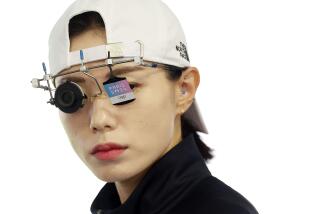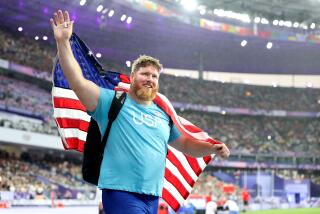A Shooting Star at Age 73 : For Tom Amberry, the King of Free Throws, Aiming High Increases His Net Worth
- Share via
When Tom Amberry was a teen-ager, he dreamed of being a basketball star. At 73, his dream has come true--in a most unlikely way.
As one sports announcer recently told a cheering halftime crowd, Amberry is “the best free-throw shooter ever to touch a basketball.”
Amberry’s sudden celebrity--hey, he’s been on Letterman--stems from his astonishing accomplishment on Nov. 15, 1993. With 20 witnesses watching, Amberry sunk 2,750 free throws in a row--a feat that took 12 hours and secured his place in the Guinness Book of World Records.
“I could have made more--a lot more,” Amberry says with characteristic confidence, “but they were closing the gym so they kicked me out.”
Two years later, Amberry’s record still stands, making him better from the line than the best young hot-shot millionaire NBA star. He is better than the best coach or trick-shot artist. He is better than any basketball legend ever was--be it Charles Barkley, Bill Sharman or the immortal Michael Jordan.
In fact, Amberry is so good from the line that one sportswriter wondered if Amberry is an idiot savant. Amberry laughs at the suggestion and answers: “If I am, why do I have to practice so much?”
*
Practice is one of Amberry’s keys to perfection. Beginning at 7 a.m. he shoots 500 free throws every day except Sunday at the Rossmoor Athletic Club in Seal Beach. On off days he misses four of those shots. On good days he makes all 500.
The retired Long Beach podiatrist believes the ability to “focus and concentrate” separates the champions from the contenders.
“You can’t tell me NBA players aren’t good shooters,” Amberry says, a Midwestern twang betraying his Grand Forks, N.D., roots. “But I’m better from the line. Why? Because I’ve learned to focus and concentrate better than anyone else.”
Doubters have charged that, unlike basketball players in games, Amberry doesn’t shoot under pressure. Amberry allows that he may not face the same pressure, but he faces pressure nonetheless. In September, 1994, Amberry shot free throws live on “Late Night With David Letterman.” He drilled the first two, missed two, then settled down and finished with 238 in an hour. Not bad considering the hoop, set up in the middle of 53rd Street in New York, was swaying in a brisk crosswind.
Challengers dog Amberry at speaking engagements and coaches’ clinics, claiming they can topple the champ. “I used to carry a $100 bill in my pocket to discourage them,” Amberry says. But now Amberry quietly takes them on--and quickly beats them. He hasn’t lost a free-throw contest in any form since nuking the former world’s record of 2,036 by more than 700.
If Amberry has really discovered something that helps players hit clutch baskets from the line, why isn’t he on the payroll of an NBA team? That may be the next chapter in this man’s unlikely story. After his national television appearances (Tom Brokaw called him “the undisputed champion of the free-throw line”) Amberry got calls from all over the world about free-throw shooting.
One coach who has already spoken to Amberry is Jerry Tarkanian, who led the Runnin’ Rebels of the University of Nevada, Las Vegas to an NCAA championship in 1990. Tarkanian, now at Fresno State, knows the free throw is a small rule that makes a big difference in the game of basketball.
“We lost the national championship to North Carolina in 1977,” Tarkanian said. “We were one for five at the free-throw line.”
After listening to Amberry describe his free-throw shooting technique, Tarkanian said, “I’ve been real fascinated by Tom Amberry. I really like the technique and steps and procedures that he’s using. I’m going to have my team try that this year.”
Amberry was brought to Tarkanian’s attention by John Welch, Fresno State’s assistant coach, who met him while coaching at Cal State Long Beach. Amberry appeared at Welch’s desk one day, claiming to be the world’s champion.
“I looked at this tall, white-haired gentleman and, well, I didn’t know what to think,” Welch recalls. They went to the gym and Welch asked Amberry to shoot and make 25. He did. That got Welch’s attention.
Amberry taught Welch how to focus and concentrate and Welch immediately hit 68 free throws in a row. The next day, he made 98 out of 100. Now Welch is sold on Amberry, adding: “He’s by far the best I’ve been around.”
UCLA Coach Jim Harrick is also familiar with Amberry and comments. “He has made an art and science of free-throw shooting,” he says.
Meanwhile, Amberry is coaching junior and senior high school and college players at Bob Gottlieb’s Branch West Basketball Academy in Orange County. The results he is getting amazes even him.
“We have some kids here that couldn’t shoot a lick,” says Gottlieb, a coach since 1963. “Tom will call me over and say, ‘He’s just made 14 in a row.’ I believe in him.”
*
As a boy in Grand Forks, Amberry loved basketball so much that he would shoot at a hoop on the side of his barn even with ice and snow on the ground. If his mother made him come indoors, he shot at a mark he made above the kitchen door. Growing to 6 feet, 7 inches, he was a star at City College in Long Beach and was twice the nation’s high scorer.
But Amberry’s dream of a basketball career was interrupted by World War II. After four years on a destroyer in the Atlantic and Pacific, he felt his best ball-playing years were behind him. He turned down a $10,000 two-year, no-cut contract with the Minneapolis Lakers to go to podiatry school.
For the next 40 years Amberry didn’t touch a basketball. With his wife, Helen, he raised four boys and built a successful practice in Long Beach.
After retiring at the end of 1991, Amberry found he had too much time and too little to do. “At the end of the day, I felt I didn’t accomplish anything,” he says. “I mean, how many times can you vacuum the carpet and get satisfaction from it?”
A friend suggested he shoot some baskets to stay in shape. “At first I couldn’t shoot 50 baskets in a day,” Amberry recalls. “I don’t mean make 50 baskets--I mean shoot 50.”
But Amberry kept at it, determined to enter the free-throw shooting competitions at the Senior Olympics. His method for improvement was simply to practice. In fact, he practiced so much his left arm gave out. He switched to a right-handed shot.
As Amberry competed at free-throw shooting events around the country, he met the best coaches in the game. Buzz Braman, who works with the Orlando Magic, taught Amberry to keep his eye on the basket even when the ball is in flight. John Scott, who produces instructional videos, told him to keep his elbow in. Floyd Strain, a sports psychologist in Payette, Ida., told Amberry to visualize that his arm was 15 feet long and he was just dropping the ball in the basket.
Amberry took what he learned and combined it into a seven-step method. His process is unique because it combines the physical and mental steps necessary to make a free throw. He has recently completed a book and video explaining his technique in detail.
While retirement has meant a gradual reduction of ability and activity for many seniors, Amberry finds himself on a strange and wonderful journey. “I’ve had two years of fun and glory,” he says. “I’ve had the chance to meet the greatest names in the game and play the sport I love. You can’t beat that.”
For now, Amberry’s record appears safe. In fact, the only competition may be himself. This year he’s considering going for a new record of 4,500.
More to Read
Go beyond the scoreboard
Get the latest on L.A.'s teams in the daily Sports Report newsletter.
You may occasionally receive promotional content from the Los Angeles Times.










